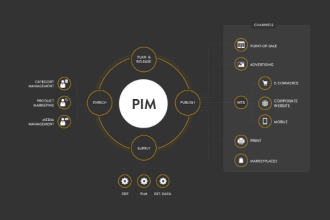The need for dependable and efficient LMS for employee onboarding has exploded as companies adopt online training and e-learning initiatives at an increasing rate. Choosing the best LMS solution can be difficult, especially with the variety of options on the market. According to AcademyOcean experience, it is critical to account for your organization’s unique demands and requirements while considering LMS solutions with the features that will help you achieve your goals and objectives. This article outlines the key characteristics to consider while choosing an enterprise LMS solution.
Intuitive User Interface
Your staff is more likely to accept and use an LMS system effectively if it is simple, convenient, and intuitive. Employees should have no trouble navigating a decent LMS user interface, which should be clear, uncomplicated, and well-designed. It comprises an easy-to-use dashboard, a structured navigation menu, and logical icons and buttons listed among LMS features.
Certification
Certification must be a part of training and the development of enterprise learning platforms. An LMS system should make it simple for workers to get and maintain their certifications. Using a capable LMS, you should be able to manage certification production and track employee certification progress. Employees should have access to certification records, including printed ones. Administrators should receive information on the number of employees holding certifications in specific disciplines.
Reporting & Analytics
An LMS solution must have reporting and analytics since they give you information about how well your training programs are doing and let you gauge and enhance their effects. Data on employee training progress, completion rates, and other information should be available in comprehensive reports that can be customized by users of a decent LMS. Administrators should be able to track the performance of specific employees as well as the entire company using these reports, which should be simple to export and share.
The ease of collecting, sharing, using, and monitoring the reporting data is among the top LMS features. These processes allow business owners to adjust their training programs, working routines, practices, and policies on the go to meet their goals. This data also helps to build future development plans and, more precisely, correlate them with actual capabilities and team qualifications.
Compatibility And Integration
If your company already uses other software systems, it’s particularly crucial to add interoperability and integration possibilities to your LMS functionality checklist. An LMS solution should allow for smooth data exchange and interaction with your current systems, including HR, payroll, and CRM platforms. As a result, your team won’t waste time manually transferring the data. Plus, this feature also takes accuracy and consistency to a new level, as automatic transfer completely annihilates the risk of human mistakes.
Gamification Possibilities
Gamification, which is the application of game design aspects to non-game environments, has the potential to be a powerful tool for boosting employee motivation and engagement. Achievements, leaderboards, and challenge modes are examples of gamification features that enable employees to compete and work together in an effective LMS solution. These features boost the likelihood that your training programs will be successful and make learning more captivating and engaging for the learners.
Achievements
Achievements are crucial LMS features since they keep users motivated and interested. An achievement system enables learners to be commended and rewarded for their achievements. It can involve completing training programs or reaching predetermined benchmarks, including tests or courses.
A supportive and motivating learning environment of an LMS can be greatly supplemented by the rewards and accolades that come with accomplishments. When users see their progress and receive praise for their efforts, then they are more likely to feel inspired to continue learning and achieve their goals. This sensation of accomplishment can also increase the user’s self-esteem and confidence—improving general performance.
Leaderboards
Utilizing leaderboards, which are another competitive feature, might encourage learners to finish training courses and will allow them to show stunning performance on exams. A leaderboard may be an excellent tool for fostering friendly competition and inspiring people to push themselves to improve their performance. All users’ results can be displayed on the scoreboard, which can also be ranked according to variable criteria like total points, completion rate, or evaluation scores specially adjusted for every course.
Challenge Mode
An excellent feature for an LMS to have is challenge mode because it gives learners an entertaining and comprehensive approach to finishing their training. Users are motivated to complete their training programs or tests on time by adding a competitive element. Users may finish their training more quickly due to this sense of urgency, which ultimately helps the business by ensuring all staff members have access to the most recent information and training.
The LMS must include a well-thought-out leaderboard system to maximize the effectiveness of the challenge mode. The leaderboard must have a clear list of competitors and ranks that are easy to grasp. For users to follow their progress and always know where they stand, it should also be updated in real-time. This level of openness and accessibility is necessary to guarantee that challenge mode is a powerful instrument for user motivation.
Customer Service
When making the most important LMS features comparison, always put customer support high. It is a crucial feature to look for in a business LMS package. An effective LMS vendor should offer first-rate CSM to help you with any issues or questions you might have when setting up and using the system. The vendor must have a devoted customer service team and offer multiple support options, such as live chat, email, and phone. Don’t forget to check client testimonials and contact references before selecting a provider to ensure they have a track record of providing excellent customer support.
LMS White-label
Another factor to consider is whether an LMS with a white label is available. You can identify the white-label e-learning platform specifically if it allows you to use your logo, color scheme, and domain name. It is an exceptional way to give your users a more consistent and seamless experience because you won’t be redirecting them to another website or platform. Therefore, they will have a feeling of staying inside your system and building trust with your company or organization. Additionally, this feature provides each user with a customized experience while giving you more control over the look and feel of the platform.
To sum up, these are a few of the most crucial features to look for in an enterprise LMS package. When evaluating an LMS, take into account the friendly user interface, accreditation, reporting and analytics, interoperability and integration, gamification potential, support, and LMS white-label options. By taking the time to select the most promising LMS for your business, you can ensure that your workforce has access to the training and development programs they need to succeed and grow.















